
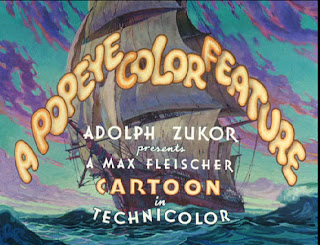
The Home For Orphan Toons proudly presents this newly-"adopted" classic from the DVD collection Popeye The Sailor: Vol. 1 1933-1938, lovingly restored thanks to the painstaking efforts of Jerry Beck....
Popeye The Sailor Meets Sindbad The Sailor
Release Date: Nov. 27, 1936 (A Popeye Color Special)
Director: Dave Fleischer (key animators Willard Bowsky and George Germanetti)
In short: Two legendary sailors clash--care to guess who wins?
I've long had a certain fascination with--and pity for--Max Fleischer. Fascination because he advanced the art and technique of animation when his future rival Walt Disney still struggled with the rudiments of the form in Kansas City. Fleischer's cartoons were fluid and naturalistic when most "animated" cartoons still looked like glorified comic strips. He experimented with sound a full four years before Walt made STEAMBOAT WILLIE, and invented a 3D process (utilizing miniature sets, built and painted to match the "cartoony" look of the foreground characters) that seemed ingeniously simple in comparison to Disney's monstrous multiplane camera.
Yet despite the great strides he took in the field of animation, he would not receive proper recognition for it for decades.
In that sense, he had a great deal in common with another long-unsung genius of the medium, Ub Iwerks. Iwerks, too, had a fascination with things technical, and would devote the latter years of his career to developing new special effects processes for film (as in the avian animatronic figures for Alfred Hitchcock's groundbreaking suspense film THE BIRDS in 1963). Both Iwerks and Fleischer had a rubbery, freewheeling, "anything goes" approach to animation--and both would ultimately, despite their best efforts, lose their studios and their independence.
Fleischer's fascination with science and machinery was boundless--he had, after all, been the art editor of POPULAR SCIENCE MONTHLY early in his artistic career; his drawings of the latest technical marvels resemble photographs. He made a series of educational films in the early twenties on such subjects as Einstein's theory of relativity and the theory of evolution, using a combination of live action footage and minimally animated graphs. Critics of the time said he explained the theory of relativity in such a way that even the scientists could understand it.
Unfortunately, like Iwerks, he had often been dismissed by animation historians as a mere mechanic with little regard for, or interest in, the art of animation. For both men, we were told, animation was simply a means to an end, a medium in which to test new filmmaking techniques.
Leonard Maltin in OF MICE AND MAGIC is perhaps the most blunt:
He was more interested in mechanical innovations than artistic ones, and this hampered his studio when Disney was setting a high standard for the competition to meet. During the twenties and early thirties, Fleischer had some of the most talented, and most promising, men in the animated field working for him, but most of them left the studio to go west and settle at Disney's. They recognized the challenge, and potential for growth, that Max could not provide.
One New York animator [later comments], Those people who were quite content with the raw, peasant humor, the bad drawing, the kind of not-too-thought-out timing and the simpleminded stories--that bunch stayed here. The more adventurous, who really wanted to learn to make a better movie, left here. Every one of them..." (pp. 82-83).
Shamus Culhane, in his book TALKING ANIMALS AND OTHER PEOPLE, shared a similar
disdain for the Fleischer artist's supposed lack of polish in their animaton, saying repeatedly how frustrated he was with the animators' propensity for drawing their characters with both feet firmly planted, regardless of the body's position.
Today, however, these "flaws" are largely seen as strengths by fans--rather than appear unimaginative, the Fleischers' tendency to draw characters as they did, with feet firmly planted, actually helped the characters "read" better in the variegated dirty gray backgrounds of the black-and-white Popeyes and Betty Boops.
As for the "peasant humor"--well, generations of fans love the Fleischer studio for it, and lament the day Betty Boop's skirts lowered. Bad drawing? These were artists who knew what they were doing, with a masterful knowledge of perspective--they used such tricks as foreshortening in cartoons like THE PANELESS WINDOW WASHER and I SKI, LOVE SKI, YOU SKI. In the latter film, when Popeye, Bluto and Olive scale the mountain in long shot, the camera tracks them continuously, keeping them in the center of the film frame so their action continue to "read", even from a distance. (As animator John Kricfalusi gleefully points out on the commentary track.)
In the early Popeye cartoon A DREAM WALKING from 1934, Popeye climbs a building under
construction, the camera following as he swings from girder to girder. Each girder is in perspective, and moving downward as Popeye advances. That takes precise technical and mathematical knowledge, hardly the domain of the hack.
If anything, the mass migration of artists to Disney only encouraged Fleischer to innovate further. He would attempt to compete with Disney on his own turf with longer stories, while retaining touches that were typically Fleischer. In 1936, he, along with every other cartoon producer in the business, was well aware of what Disney was attempting on the other coast: a full-length animated feature, SNOW WHITE AND THE SEVEN DWARFS. Rather than denigrate it as "Disney's Folly" as many of his colleagues had done, Fleischer saw it as a challenge. If Disney could make features, so could he.
Paramount, his distributor, was not so optimistic. Still, Max managed to coax enough money out of them to produce a two-reeler--more than twice as long as a traditional short cartoon--featuring what was inarguably his most popular character of the time, Popeye The Sailor, in full, vivid 3-strip Techicolor. (1936 marked the first year in which this technical development was available to cartoon studios other than Disney, so Fleischer's timing was fortuitous). Deciding on a traditional (and conveniently public-domain) epic (rom 1001 ARABIAN NIGHTS, Fleischer deposits our hero
into the world of another famous sailor, Sindbad. And surprisingly, it works.
But fasten the seat belts on your flying carpet tightly, folks. At seventeen minutes, this is a long ride, punctuated throughout by my Fleischer-ish "mutterings."
 These "before and after" screen shots show the astonishing original beauty of a once long-neglected cartoon. One can actually see the background details once again...
These "before and after" screen shots show the astonishing original beauty of a once long-neglected cartoon. One can actually see the background details once again...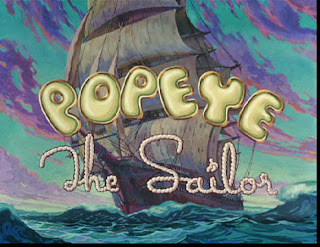 The Paramount logo, in vivid blue against a background of mauve, fades to the opening credits, here presented like a movie cast list. (With Popeye as--of course--"The Spinach-Eating Sailor" and Olive as "The Irresistible Damsel".)
The Paramount logo, in vivid blue against a background of mauve, fades to the opening credits, here presented like a movie cast list. (With Popeye as--of course--"The Spinach-Eating Sailor" and Olive as "The Irresistible Damsel".)Our story opens with a tracking shot of a vast island as two pillars rapidly part (a move I admittedly never noticed until John K. and Eddie Fitzgerald mentioned it--thanks, guys). The scene dissolves to reveal snakes, coiled and hissing, around a sign reading ISLE OF SINDBAD--BEWARE!! Take careful notice of the rocks in the background--they're actually part of a tabletop 3D set.
The camera tracks upward to reveal a menagerie of strange creatures, a dragon and various other large lizards, tigers, wildcats, and what look to be apes. As the camera continues to track upward (how did they stage this shot? It seems continuous) we see for the first time Sindbad's imposing castle, guarded by a pair of lions. The door opens and out walks the island's ruler, Sindbad himself (who looks suspiciously like Bluto, if you ask me). Before we can even take a good look at this
towering specimen, he launches into his boastful opening song (as is usual for anything from Fleischer, this proves to be one of the highlights of the cartoon).
He also doesn't have skin like Homer Simpson anymore...
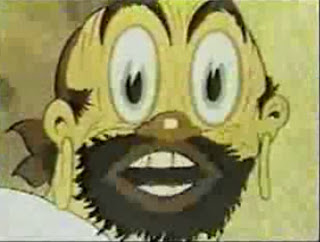
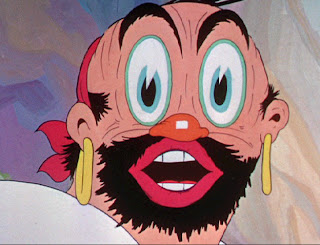
We immediately know this is not a man to be reckoned with: he punches the lions guarding his castle when they dare roar at him--the other creatures can only fearfully squawk in answer to his musical question "Who's the most remarkable, extraordinary fellow?" One poor gigantic serpent who squawks out of turn gets an imprint of Sindbad's boot on his face for his trouble. Sindbad is literally bigger than life, thrusting his face toward the audience at intervals so that his face nearly fills the screen for a fraction of a second (those creepy close-ups thanks to Fleischer's best "character" aniamtor, Willard Bowsky). Bowsky's closeups, incidentally, are the perfect complement to the bombastic opening music--on the line "All I say is BOO and my enemies run", Sindbad's eyes widen until they seem to take up most of his head, and you can see every wrinkle, every detal (even the narrow ring of blue around his eyes). If they wanted Sindbad to be scary, they succeeded.
Passing a cache of treasure guarded by the aforementioned serpents, he brags, "From the valley of serpents these diamonds I took/I cleaned out those serpents with one dirty look..." Just in case we don't believe him, he proceeds to demonstrate, flashing a patented dirty look at the serpent guards, who collapse in a dead faint--or just plain dead...it's hard to tell.
Just when we think we've slipped irretrievably into Disney territory, the music changes abruptly as Sindbad passes through a cave, switching to a hot little swing riff. We're back in Fleischer land, folks.
The cave is, of course, another set, adorned with 3-D skeletons and with veins of pastel colors. It's worth pausing to get the full effect--you might have to look twice to realize it was built, not drawn.
Sindbad passes a two-headed giant, easily three times his size. We think for a moment he (they?) will overpower him as they break loose from their chains, but he makes them cower with a threatening gesture and a reprise of the song's chorus. The giant, whose name is Boola, can only mutter discontentedly in a vaudeville Greek accent.
As he moves along, Sindbad introduces us to the most fearsome creature of all, the Rokh, a pterodactyl-like bird with the wingspan of a 747. Sindbad looks like a worm in comparison, but no matter, or so he tells us: "He had me in his beak, but *I* ran off with him!"
We've long since gotten the idea that Sindbad is master of all he surveys--or is he? His song is interrupted rudely in the fourth chorus or so by another song--one quite familiar, in fact. Yes, it's none other than that of Popeye. We get our first Technicolor view of Popeye and his friends through Sindbad's telescope as he investigates just who "dares to challenge Sindbad's power."
Popeye steers his small craft as Olive strikes a pose on deck, and Wimpy does what Wimpy does best, eating hamburgers.
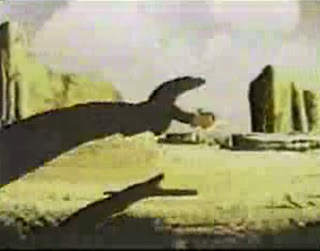
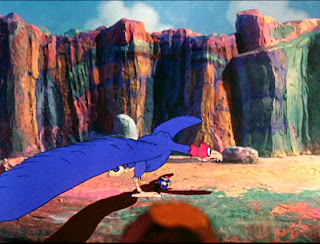
The enraged Sindbad whistles for the Rokh, ordering him to "wreck that ship--but bring ME the woman...." (Anybody get the idea he's been on that island too long?)
As always in a Fleischer cartoon, it's the details that make it charming. I was always tickled by little touches, such as the little musical flourish as Popeye moves his pipe out of the way of the ship's wheel. Not that the bigger ones aren't impressive--as the Rokh takes off, we see a large portion of the 3D set in long shot. The panoramic view lasts probably five or six seconds, and doesn't seem to repeat itself. Every single boulder is streaked with a rainbow of colors--so many
one wonders how long it took to paint, let alone film. To look more real, it was photographed with a narrow depth of field, no more than six feet, which gives the appropriate effect of sharpening the foreground while blurring the background, further obscuring the fact that these backgrounds are not drawings.
To further disprove the notion these artists were incompetent hacks, watch the Rokh in flight as it circles the ship. It seems to be done with more than a passing knowledge of a real bird's anatomy. True, it lapses into "rubber hose" territory when it slaps the ship into splinters, but as that's a more "humanized" bit of business, the "cartooniness" of it is hardly out of place.
Popeye, meanwhile pulls himself and Wimpy from the water and onto the capsized wreck. As he looks through his telescope he sees the Rokh in the distance carrying Olive to Sindbad's island (she's still feisty in this cartoon, pounding and fighting all the way.)
It's here we get the first, at least in this cartoon, of Popeye's patented off-the-cuff mutterings..."that was a nice boat we had once..." Referring to the Rokh, he says, "That's the biggest buzzard I ever saw...look at that fella go.." One can only imagine the humor lost if Fleischer had chosen to do this story in the Disney manner. And this is only halfway through the cartoon.
Popeye, through his telescope, sees the bird unceremoniously deposit Olive on the ground in front of Sindbad..she scrambles in her usual rubbery-limbed way as he approaches. When he tells her to "give us a little smack..." she responds, "I'll give ya a smack, all right, all right..." and proceeds to flail her fists at his head. (I told you she was feisty).
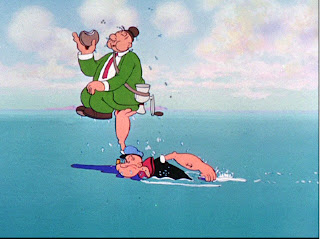
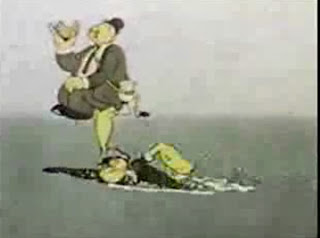
With a firm grasp of the obvious, Popeye says to Wimpy that they have to go on the island to save Olive. Jumping "into the brink" and dragging Wimpy under with him, Popeye swims for shore...he hoists Wimpy above his head. Wimpy's too busy eating his waterlogged hamburger to have any appreciation of the danger they're about to get themselves into.
Next comes my favorite muttering scene of the picture, as Popeye and Wimpy climb on shore. At the entrance to a cave, Popeye reads a sign reading the following:
FOR WHOSOEVER PASSETH IN
PASSETH OUT!
To which Popeye responds, "Well, I guess I'll go-eth in-eth!" Thanks to the audio restoration, we're able to hear that hilarious aside clearly for the very first time.
Popeye and Wimpy soon go their separate ways--Popeye inside the cave, and Wimpy in pursuit
of a passing duck, in the hopes of making him into a duckburger.
If you thought the exterior set in this restored version was awe-inspiring, you've seen nothing until you've seen the cave interior, with its stalagtites of deep red and and green and violet. Popeye continues his characteristic muttering throughout..."I wish I never came in here..." but you won't. It's one of the many reasons we should be glad this was restored.
"I wish I never came in here..." But you gotta admit, Popeye, it "looksk purty"...
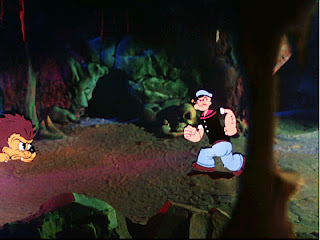
Coming upon two lions who have the temerity to roar at him, he merely roars back, sending them scurrying. Considering how ugly (or uglier) he makes his face when he pulls it, I think it would frighten me.
Hearing Olive's cries for help on the other side of a stone wall, Popeye merely drills his way
through with his body to the other side. Once there, he sees Sindbad has decided to use her for a little impromptu entertainment: shooting pebbles at her with a pea shooter to make her "dance" (I'm guessing her flapping, flailing dance was animated by Dave Tendlar--it resembles one of his
"flurry" moves. Or what I like to call the "Dave Tendlar Shuffle."
Olive rushes toward Popeye, only to be flung back toward the cliff face like a rag doll. Popeye's
about to react to this brutality when they're interrupted by a running gag--Wimpy and the duck. He chases it between and around Popeye and Sindbad, then toward a hole in the rock face, where the duck escapes. Wimpy snaps his fingers and mutters, "I guess I shall have to resort to my last hamburger..." But he doesn't get that either, as the duck reaches out and grabs it.
But back to the main event--Sindbad's cruisin' for a bruisin', and Popeye's all too willing to give it
to him. It's just now, at about the ten-minute mark in the cartoon, that we get to the introductions.
Sindbad bellows, "Who are you?" Popeye responds with his signature song, and when Popeye
asks the same question, Sindbad sputters in frustration and responds with his, the animals
screeching in affirmation. (Though truthfully, it really doesn't give Popeye any clues as to who this guy is. Not that it matters: to Popeye he's just a guy about to get "twisker-punched".)
During the reprise of his number, Sindbad subjects Popeye to a number ot minor abuses--pulling out his shirt tail, poking him in the eye, shoving his pipe inside his mouth. But to his frequent question of "Who's the most remarkable, extraordinary fellow?" Popeye has just one answer--"Popeye The Sailor." And proceeds to pull out Sindbad's shirt tail, with the typical
muttered remark ("Ya better fix your shirt there, young fella...")
Let the fun begin, because at this point we get to the main reason to watch any Popeye
cartoon--to see him and Bluto (or in this case, a Bluto lookalike) beat the tar out of each other.
Too bad it takes until the two-thirds mark of the cartoon to get to it. But as they say, the best
things are worth waiting for...
Grabbing Popeye by the shoulders in a vise grip and tossing him off camera toward the Rokh,
Sindbad taunts, "Well, let's see how great you are!!"
Popeye shows him--from a worm's eye view we see the Rokh circling overhead with Popeye in his claws. They head toward an active volcano in the distance and certain doom. But not for
Roast Rokh--"with gravy," and "grief smoke"...

Popeye--as Olive weeps for his loss, a whirlwind returns to Sindbad's island, and it's revealed to
be Popeye--and a ROAST Rokh. "With gravy", as Popeye says. (John Kricfalusi has an odd term for the black smoke rising off the bird's roasted carcass--'grief smoke.' I have to confess, in thirty years of watching and analyzing cartoons, I've never head THAT expression before.) That's one down...
,,,but still several more to go, as now Popeye gets thrown into the waiting brawny arms of Boola
the two-headed Greek giant. They attempt to "put him to sleep" with
various punches to the face and pokes in the eye.
This giant doesn't know it yet, but it's about to be "put to sleep..."
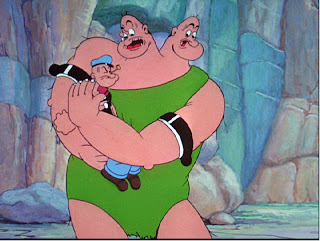
As they argue over whether or not to make Popeye into "chopped Popeye fric-a-see-sees"
Popeye responds, "Oh, two against one, eh?" and gives them a Three Stooges-like double slap.
Thrown to the ground, Popeye retailiates by charging the monster and stomping on its--uh, their, feet. They fling Popeye toward a nearby tree, which breaks on contact and falls toward Boola.
Hitting one of the heads, it raises a lump on the other, Corsican Brothers-like.
But Popeye's not done with them--Boola stomps toward him, but he merely slips under Boola's
legs and hits their weakest spot: their heads. They do a flip and land on the ground with a
thundering crash. Two down--and one to go.
Now, finally, we get to, as they say in the WWF, the "ultimate smackdown", Popeye vs. Sindbad
himself. Sindbad, after groaning in frustration, pounds his chest, saying "There's only room for one great sailor in this world, and that's ME..." Popeye steps over the remains of Boola, thumping his own chest in response to the tune of "The Girl I Left Behind Me." (When Popeye's ready to fight and there's patriotic music playing, watch out!)
While I'm at it, I'd like to interrupt the impending mayhem by pointing out a little quirk of these
cartoons. Have you ever noticed Popeye seems to be aware of his own background music? He
always hums it as it plays in the background, as he does here. Sort of a quasi-"breaking the
fourth wall" or a metacommentary along the lines of those in the series GREEN ACRES. Without saying so, Popeye seems aware he's a character in a cartoon, even to the point of enjoying the score.
But Bluto...I mean Sindbad, has yet to be pounded, so let's get back to that, shall we?
The island animals seem to know something big is going down, and they all gather round to
watch. "We're gonna come to terms right now!" Popeye yells at his advancing foe. We move to an impressive long shot of Popeye and Sindbad in the center of the "ring", so to speak, as the
animals gather around like spectators in an amphitheater.
Sindbad, with Popeye glaring up at him, stomps along, pushing Popeye along with him as he
advances. Picking Popeye up and squeezing him like a tube of toothpaste, he makes Popeye
turn beet red--literally. Popeye's head actually transforms into a beet--one of the last instances of such a metamorphosis in a Fleischer cartoon, incidentally. It's remarkably detailed in the
restoration, a purplish red with bright green leaves and a purple stem--something I could never
discern from the grainy public-domain prints. Popeye's head snaps back to normal, and he
proceeds to use it to head-butt Sindbad--"Beet for beat, fella!" he says.
How does it feel to be socked in three-strip Technicolor?
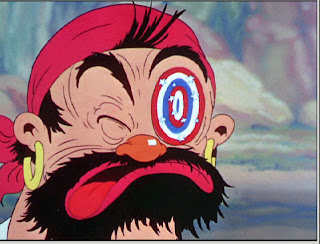
Infuriated, Sindbad hurls Popeye into a hollow tree--as he looks inside, Popeye hollers "Peek-a
boo!" and gives him one heck of a sock in the face. Sindbad stumbles back toward another tree,
but before he can regain his footing, we see evidence of something tunneling under the ground
toward the second tree. Popeye's fist emerges from the other tree as he says "I sock you!" Since
this is full Technicolor, after all, the Fleischers can't pass up a gag exploiting it--Sindbad, instead
of a black eye, sports one in patriotic red, white and blue. (Does anyone besides me wonder
where Olive and Wimpy went to?)
Sindbad retaliates by flinging Popeye through the air--he lands on his feet and rocks back and
forth like one of those "bop-em" bags in his likeness. Sindbad proceeds to pound on our hero,
freeing things from the sailor man's pockets with every punch: an anchor, a pair of binoculars, a
ship's wheel, and a winch among them. "Do ya give up?" Popeye mumbles.
Of course, the one item in Popeye's pants pocket that Sindbad doesn't dislodge is...you guessed
it, the spinach, which Popeye removes in mid-beating. (NOW we get to the spinach? Sheesh...)
But..Sindbad punches it out of his hands, and it rolls toward a cliff to seeming oblivion. But wait...
Popeye rescues it in the nick of time, saying "Don't leave me now!" Sindbad, meanwhile, punches him over to the other side of the chasm near a tree. Pulling on his legs, he nearly manages to get
him away from the tree, but Popeye hooks himself to a branch with his pipe as his fanfare starts.
Which, as any Popeye fan knows, is the cue for the spinach. (One interviewee on this set
remarks that the Popeye theme is as much the theme of the spinach as it is Popeye's).
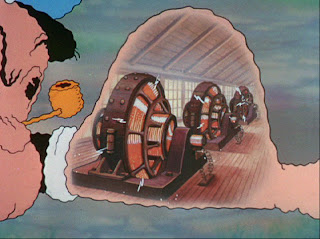
Once downing the green stuff--truly green for the first time in a Popeye cartoon--we cut to a
closeup of Popeye's bulging bicep, which contains a series of electrical generators. Those
generators appear to be vibrating, since in freeze frame, Popeye seems to be rendered in wiggly
lines.
Popeye proceeds to kick Bluto--er, sorry, SINDBAD--around with his feet like an oversized soccer ball. Sindbad in desperation picks up a rock to hurl at Popeye--it merely bounces off him and onto Sindbad. Popeye puches him toward a coconut tree--Sindbad travels up the trunk, hitting the coconuts.
As Sindbad hits the ground and heads for Popeye, Olive appears from nowhere to cheer Popeye
on, advising him to "give him the twister punch!" He does, which sends Sindbad spinning like a
party favor when Popeye punches him. He proceeds to tie a coconut and a cloth object to
Sindbad's sash and sends him up as tree: a flag unfurls to reveal Popeye's personal colors--a can
of spinach superimposed over an anchor. He sings a mocking version of Sindbad's song as
Sindbad hangs in midair, to which all assembled respond....
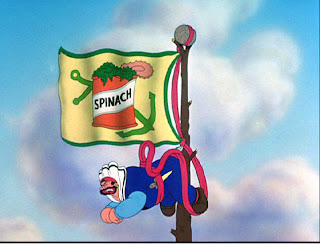
Thus ends the Fleischer's first mini-feature...and with it, my review, save for my concluding
thoughts...
How does one sum up a cartoon like this? Well, if unlike me you have some energy left, it should
be worth noting that this is one of the last of its kind. Not Technicolor specials--two more will
follow in the next three years--but the last of the "old-style" Fleischer cartoons, the unabashedly cartoony ones that animators like John Kricfalusi and Eddie Fitzgerald adore. From here on, we see less of the anthropomorphic gags, less detail in the faces (fewer of those wonderful Willard Bowsky lines) a less independent Olive Oyl, and even, for awhile, less of Bluto (there's an eleven-month interval in the late thirties when Bluto isn't seen at all, possibly because of the death of voice man Gus Wickie. When Bluto returns, he's voiced by Pinto Colvig). Secondary characters like Swee'pea, Eugene The Jeep and Poopdeck Pappy take the spotlight. In a way, then, this cartoon is both a swan song, and the beginning of a new chapter in Fleischer history. Let's savor this cartoon, because they truly don't make them like this anymore.
Is this truly an "orphan toon," you ask? Well, up to now it had been--edited, allowed to fade, the
soundtrack allowed to turn muddy, and otherwise permitted to languish in public-domain hell. One can only hope it stays "adopted."
One final word on the color: when I heard this cartoon was going to be restored, I assumed at first it would appear as other color cartoons of the era did--as a explosion of different hues. Among most of the studios, there appeared to be the feeling that audiences weren't getting their money's worth if the palette didn't burn their retinas.
Yet, the color is surprisingly, dare I say charmingly, subdued here. Fleischer, artist and
technician, was still experienting. His only other foray into color, after all, was the Cinecolor Betty Boop short POOR CINDERELLA. He had to discover which colors worked, and which didn't. Therefore the hues tend to be soft pastels, which blend nicely with those of the 3D backgrounds.
There are none of what I call "comic-book colors" here: no primaries. The reds tend toward a
reddish-violet, and mauves and cool colors predominate. Sindbad's outfit is a subtle deep blue.
Bright color, if it's used at all, is used to punctuate a gag or to help an object "read", such as
Sindbad's multicolored "shiner." Fleischer may well have been skittish about color for this first
outing--subsequent shorts show more confident use of it--but it might not have worked as well had he done it differently. Sometimes, less is indeed more.
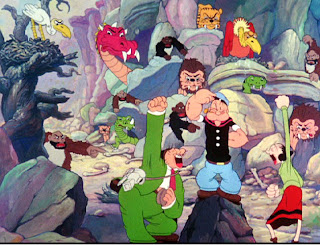
Note: an audio version of this blog entry can be heard on the Orphan Toons Podcast, at http://komicskast.libsyn.com, read by your humble toonkeeper....
Tags: Popeye+DVD+Collection, Technicolor+Special, review-synopsis, review-synopsis, orphan+toon


